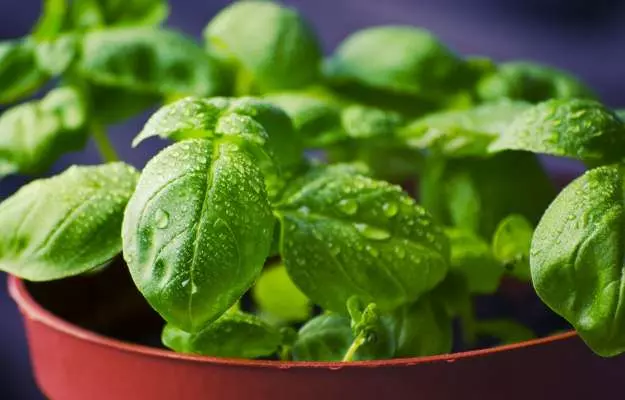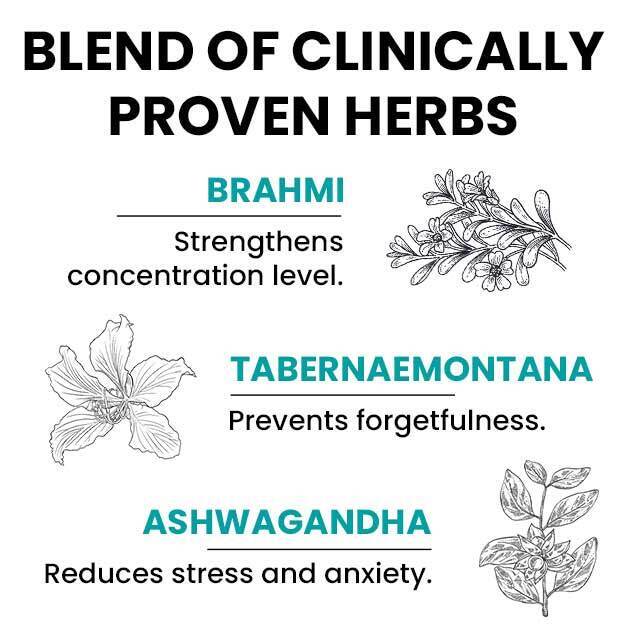Basil or Tulsi is also known the “The Queen of Herbs” or “Elixir of Life”. It has an incomparable status among the other herbs due to its medicinal, culinary and spiritual properties. There are three different varieties of Tulsi. Rama Tulsi which has green leaves, Krishna Tulsi which has purple leaves, and Vana Tulsi, which is a wild variety and has light green leaves.
Basil plants are being grown in India since the Vedic period and are held sacred by the Hindus. They are usually planted around the temples and can also be found in most Indian houses. The size and colour of the basil plants vary depending on the geography, rainfall and plant type.
It has a wide range of uses from cooking to medicine. The aromatic fragrance and bitter taste of basil is a treat to taste buds when consumed with salads and sauces. In ancient times, Tulsi was considered a symbol of purity. It was believed that even going near a Tulsi plant and smelling it can protect you from many infections.
Because of its spiritual status, it is also known as the holy basil. In Ayurveda, basil is known to provide a wide array of health benefits. Basil has anti-microbial, anti-inflammatory, anti-arthritic, chemo-preventive, hepatoprotective (protects liver), anti-diabetic, and anti-asthmatic properties.
Some Basic facts about Basil:
- Botanical Name: Ocimum sanctum
- Family: Lamiaceae
- Common Name: तुलसी Tulsi
- Sanskrit Name: Tulsi
- Other Names: Holy Basil, Rama Tulsi, Shyam Tulsi
- Origin and geographical location: Basil is native to India but it is also found in the Tropical regions from Central Africa to Southeast Asia.
- Interesting Fact: Environmentalists and scientists planted a million Tulsi plants around the Taj Mahal to protect it from the damage caused due to pollution.
Basil nutrition facts
Basil is a good source of protein, vitamins, minerals, dietary fibre, flavonoids and several organic compounds. The flavonoids present in basil can help treat acne, asthma, inflammation and respiratory issues.
According to the USDA National Nutrient Database, 100g of tulsi contains the following nutrients:
| Nutrient | Value per 100 g |
| Water | 92.06 g |
| Energy | 23 kcal |
| Protein | 3.15 g |
| Fat | 0.64 g |
| Carbohydrate | 2.65 g |
| Fiber | 1.6 g |
| Sugars | 0.30 g |
| Minerals | |
| Calcium | 177 mg |
| Iron | 3.17 mg |
| Magnesium | 64 mg |
| Phosphorus | 56 mg |
| Potassium | 295 mg |
| Sodium | 4 mg |
| Zinc | 0.81 mg |
| Vitamins | |
| Vitamin A | 264 µg |
| Vitamin B1 | 0.034 mg |
| Vitamin B2 | 0.076 mg |
| Vitamin B3 | 0.902 mg |
| Vitamin B6 | 0.155 mg |
| Vitamin B9 | 68 µg |
| Vitamin C | 18.0 mg |
| Vitamin E | 0.80 mg |
| Vitamin K | 414.8 µg |
| Fats/Fatty acid | |
| Saturated | 0.041 g |
| Monounsaturated | 0.088 g |
| Polyunsaturated | 0.389 g |
Basil health benefits
- As an antioxidant: Basil is a potent antioxidant due to the presence of bioactive compounds, which makes it excellent for the health of your skin and hair. It only protects the body from excessive oxidative stress and damage while improving the texture of the skin and hair. Additionally, it is effective against several skin infections and conditions like psoriasis, leprosy and eczema. As an antimicrobial agent, it helps in the management of skin wounds and insect bites. Concerning hair, the use of basil not only delays hair greying and fall but also baldness and alopecia.
- For oral health: Tulsi is useful in the management of dental caries, toothache and gingivitis.
- For the stomach: Basil helps in providing relief from constipation by enhancing the process of digestion. Concotion of basil is also effective in improving appetite.
- For stress: Basil is effective in the management of physical, psychological, chemical and metabolic stress.
- For eyes and ears: The use of basil leaves in the form of eye drops helps to relieve painful eye conditions like glaucoma, cataract and conjunctivitis. Basil oil also helps to relieve infections and pain in the middle ear.
- Against cancer: Several studies have explored the anti-cancer potential of basil and it has been found to be effective in the management of stomach cancer.
Basil for cancer and tumours
Cancer refers to the abnormal growth of cells in the body. Extensive research is being done worldwide to find natural alternatives for anticancer therapies since the current line of treatment is associated with several side effects. In this trend, several studies associate basil with potential anticancer properties A preclinical study was done using the extract from basil and neem leaves. The study revealed that basil extract is effective in the prevention of stomach cancer. There was also a significant reduction in the abnormal growth of cells. Another research showed that basil contains ursolic and oleanolic acids which have anti-tumour activity.
Basil also has radioprotective ability which can protect the healthy cells from the harmful effects of radiation. Additionally, the anti-inflammatory property of basil prevents inflammation which is increasingly being associated with cancer.
Basil antioxidant capacity
Free radicals are unstable molecules that cause cell damage and results in various diseases such as cancer and cardiovascular problems. Antioxidants are the natural substances that protect you from the damage caused due to the free radicals. So, it is essential to maintain a balance between the free radicals and antioxidants. An imbalance between these two is termed as oxidative stress. Several studies show that basil has the ability to protect the body from oxidative damage due to the high levels of antioxidants present in it.
An animal study indicates that a herbal powder containing basil as a primary ingredient exhibits significant antioxidant properties. Another preclinical study showed that basil extract had high levels of antioxidants such as catalase and glutathione transferase.
(Read more: Antioxidant food sources)
Basil benefits for hair
As people age, they tend to face issues not just with their skin, but also with their hair. Greying of hair, hair loss, thinning of hair and balding are some of the common issues that people face with age. Some of the common causes for these hair problems include stress, hormonal imbalance, hereditary problems and use of certain medicines. Basil is a storehouse of antioxidants which have been found to reduce hair greying and protect them from pollution and UV damage.
Androgenic alopecia is a condition characterised by excessive hair loss and baldness. A research revealed the potential of basil to prevent this condition. According to the research, the root culture of basil prevents the activity of the enzyme that is responsible for hair loss. The root culture also helped in the regrowth of hair. The study further indicated that hair loss had reduced by 31% after just two months of application.
Basil benefits for skin
Basil is anything but a blessing for the skin. Traditional medicine swears by the many skin healing benefits of basil. Several studies indicate the potential of basil to protect your skin from diseases such as eczema, psoriasis, leprosy and staph infections.
Basil extract is known to have antifungal and antimicrobial properties. So, it acts as a great antiseptic for open wounds. In Ayurveda, the paste made from tulsi leaves is applied on the skin to prevent the irritation caused due to insect bites. The presence of ursolic acid in basil can prevent wrinkles, make the skin more elastic, heal wounds quickly and also helps prevent skin cancer.
Another study suggested that basil leaves are effective against S. aureus, the causative agent of skin infections. The antimicrobial activity of basil is attributed to the presence of components such as camphor, eucalyptol, eugenol, and β-caryophyllene.
Basil benefits for teeth and gums
Research suggests that chewing a few leaves of basil can help maintain dental hygiene. Tulsi is effective against a type of bacteria called Streptococcus mutans that causes dental caries. This is attributed to the presence of antibacterial agents such as Carracrol, Tetpene and Sesquiterpene b-caryophyllene in basil plant.
The presence of eugenol in basil makes it a good analgesic (painkiller) which can help reduce toothache. Sun-dried tulsi leaves can be powdered to be used as a tooth powder.
Gingivitis is a common gum disease that causes inflamed gums. Brushing the gums with tulsi powder can help prevent this disease.
Basil for gastrointestinal disorders
Gastrointestinal disorders include conditions such as irritable bowel syndrome, constipation and anal fissures. Some of these conditions could be chronic and lead to more complicated problems such as colon cancer. Research indicates the potential of basil leaves to treat gastrointestinal disorders. A decoction made from tulsi is known to cure the illness faster. Basil also improves your appetite. Basil is known to have laxative properties which can help prevent constipation and keep the bowel movements regular.
Basil leaf juice can help prevent dysentery and inflammation of the digestive tract (dyspepsia). A preclinical study reported reduced acidity and gastric ulcers on consumption of basil.
Basil for stress
Basil is considered a powerful anti-stress agent. Several studies have reported that basil is effective against physical, psychological, chemical as well as metabolic stress.
A preclinical study done to evaluate the antistress effect of basil showed that it was effective in preventing the increase of cortisol, the stress hormone of the body. The research further indicated that the presence of ursolic acid in basil is responsible for its antistress property.
(Read more: Stress treatment)
Basil benefits for eyes
Eyes are one of the most important sensory organs. However, as we age, our vision tends to become weak and the probability of getting eye diseases increases sharply. Some of the most common eye diseases include age-related macular degeneration, cataract, and glaucoma (buildup of pressure in the eye).
Ayurveda has always used basil as one of the most important ingredients in the preparation of eye medicines. According to Ayurveda, basil leaf extract, when used in the form of eye drops, can help prevent painful eye diseases such as glaucoma, cataract and conjunctivitis.
Basil benefits for ears
Ear pain can be caused due to inflammation, injury or infection in the ear. Research suggests that basil could be effective in reducing ear pain and infection. Tulsi oil made using tulsi leaves and fresh garlic juice can be used to treat earaches.
Acute otitis media is a painful condition in which the middle ear becomes infected with a bacteria, Haemophilus influenzae. A preclinical study was done to access the antimicrobial activity of basil oil against acute otitis media. The research revealed that basil oil placed in the ear canal can be an effective treatment for the disease.
Basil side effects
- Consumption of basil in excessive quantities by pregnant women may have long-term complications on both the mother and the child. Basil has the possibility of triggering uterine contractions in pregnant women. So, pregnant women are advised to talk to a doctor before consuming basil.
- Preclinical studies stated that basil reduces fertility levels in the body. Women who are trying to conceive or breastfeeding should avoid using basil. Regular consumption of basil leaves might also affect the fertility levels in men, as it is found to reduce the sperm count.
- Eugenol is a powerful compound present in basil. It has been found to possess anti-inflammatory, antibacterial and antiseptic properties. However, eugenol overdose can lead to shallow breathing, mouth and throat inflammation, nausea, rapid heartbeat, seizures and dizziness.
Find women health information
Takeaway
Tulsi, the elixir of life has numerous health benefits. Not only does it help in protecting the eyes, ears and teeth but also it is a potential anticancer agent. It exhibits antibacterial, antimicrobial and antifungal properties and it is loaded with antioxidants. However, pregnant women and women who are trying to conceive should avoid using basil. It is known to reduce the sperm count in men as well. Therefore, it is important to consume tulsi in moderate quantities that will benefit the health.
Medicines / Products that contain Tulsi
- Myupchar Ayurveda Tulsi Drops - ₹286
- Dindayal Aushadhi Immuno Plus Kadha - ₹155
- Herbal Canada Amla Ras - ₹119
- Maha Herbals Plato Max Tablet - ₹230
- Dhootapapeshwar Tribhuvankeerti Rasa (50) - ₹180
- Herbal Canada Tulsi 100 (Drop) 30ml - ₹195
- Herbal Canada Tulsi 100 30ml - ₹170
- Herbal Canada Sugar Control Tablet (240) - ₹1000
- Siddhayu Breathe Yogue - ₹335
- Himalaya Anti Dandruff Hair Cream - ₹97
- Herbal Canada Ashwagandha Capsule (30) - ₹143
- Morsan Tulsi Capsule - ₹405
- Mahaved Size Up Capsule - ₹1350
- Aimil Amlycure Syrup 200ml - ₹209
- Siddhayu Cof Yogue Syrup - ₹148
- Herbal Canada Sugar Control Tablet (60) - ₹300
- Baidyanath Nagpur Ayush Kwath Tablet - ₹119
- Himalaya Koflet SF Linctus - ₹106
- Kerala Ayurveda Vilwadi Pills - ₹199
- Kerala Ayurveda Sinactil - ₹199
- Cureado Stemkof Tablet - ₹478
- Herbal Canada Giloy Ras - ₹165
- Herbal Canada Punarnva Makoya Juice - ₹250
- Upakarma Ayurveda Tulsi Drops - ₹229
- Biogetica Metasolve Tablet - ₹559
- Bipha Ayurveda Ayush Kwath Herbal Drink Tea - ₹180
- Butterfly Ayurveda Bronchiofly Syrup - ₹100
- Planet Ayurveda Tumotrim Capsule - ₹1450
- Biogetica Immunofree Tablet - ₹719
- Himalaya Tulasi Tablet - ₹142
- Unjha Somkalpam Syrup - ₹181
- Dabur Active Antacid Syrup - ₹135
- Patanjali Tulsi Panchang Juice - ₹90
- Herbal Canada Panch Tulsi Drop 30ML - ₹161
- HS Ayurveda Lingplus Oil - ₹599
- Siddhayu Immune Yogue Junior - ₹276
- Herbal Canada Aloevera Amla Ras - ₹161
- Baidyanath Nagpur Amrit Tulsi - ₹187
- Planet Ayurveda Tulsi Powder - ₹500
- Maha Herbals Blood Detoxy Syrup - ₹138
- Cave Ayurveda Advanced Herbal Protein Shampoo (200ml) - ₹229
- Alka Ayurvedic Pharmacy Ayush Kwath - ₹79
- Herbal Canada Virya Paushtic Tablet (50) - ₹164
- Baidyanath Nagpur Ayush Kwath Churna - ₹106
- Mahaved Coldine Capsule - ₹185
- Kudos Tulsi Gold Green Tea Pack of 2 - ₹380
- Aryan Shakti Haldi Ginger Tulsi Drops - ₹225
- Ultra Healthcare Immunity Booster Syrup - ₹120
- Ultra Healthcare Dyplate Syrup - ₹170
- Biogetica Core Immunity Kit (ImmunoFree+Reginmune-30) - ₹1803
References
- United States Department of Agriculture Agricultural Research Service. Basic Report: 02044, Basil, fresh. National Nutrient Database for Standard Reference Legacy Release [Internet]
- Yuvaraj Ponnusam et al. Antioxidant Activity of The Ancient Herb, Holy Basil in CCl4-Induced Liver Injury in Rats. Ayurvedic. 2015 Nov; 2(2): 34–38. PMID: 26925464
- Eshrat Halim M. A. Hussain, Kaiser Jamil, Mala Rao. Hypoglycaemic, hypolipidemic and antioxidant properties of tulsi (Ocimum sanctum linn) on streptozotocin induced diabetes in rats. Indian J Clin Biochem. 2001 Jul; 16(2): 190–194. PMID: 23105316
- Marc Maurice Cohen. Tulsi - Ocimum sanctum: A herb for all reasons. J Ayurveda Integr Med. 2014 Oct-Dec; 5(4): 251–259. PMID: 25624701
- Manikandan P, Vidjaya Letchoumy P, Prathiba D, Nagini S. Combinatorial chemopreventive effect of Azadirachta indica and Ocimum sanctum on oxidant-antioxidant status, cell proliferation, apoptosis and angiogenesis in a rat forestomach carcinogenesis model.. Singapore Med J. 2008 Oct;49(10):814-22. PMID: 18946617
- Seth Rakoff-Nahoum. Why Cancer and Inflammation? Yale J Biol Med. 2006 Dec; 79(3-4): 123–130. PMID: 17940622
- Hanaa A. Yamani et al. Antimicrobial Activity of Tulsi (Ocimum tenuiflorum) Essential Oil and Their Major Constituents against Three Species of Bacteria. Front Microbiol. 2016; 7: 681. PMID: 27242708
- Fernández E et al. Efficacy of antioxidants in human hair. J Photochem Photobiol B. 2012 Dec 5;117:146-56. PMID: 23123594
- Kristinsson KG et al. Effective treatment of experimental acute otitis media by application of volatile fluids into the ear canal. J Infect Dis. 2005 Jun 1;191(11):1876-80. Epub 2005 Apr 29. PMID: 15871121
- Marc Maurice Cohen. Tulsi - Ocimum sanctum: A herb for all reasons. J Ayurveda Integr Med. 2014 Oct-Dec; 5(4): 251–259. PMID: 25624701
- Hojjat Rouhi-Boroujeni et al. Use of lipid-lowering medicinal herbs during pregnancy: A systematic review on safety and dosage. ARYA Atheroscler. 2017 May; 13(3): 135–155. PMID: 29147122


































